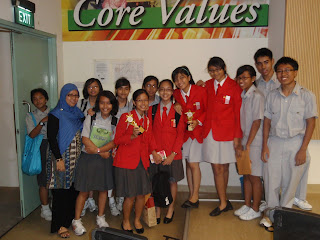Sila lihat hasil kajian awak semua... sila baca dan buat persediaan secara mental untuk menjawab soalan2 berkaitan makanan Melayu yang disajikan sewaktu hari raya khususnya, yang mungkin akan diajukan oleh kawan2 atau para guru pada hari khamis nanti...
Berikan 1 komen (1 soalan yang mungkin akan ditanya) berkaitan makanan Melayu dalam blog ini.
Royal delicacies at peasant prices
KUIH TART Kuih Tart Nenas are basically Pineapple Tarts in Malay. Kuih Tart are made of flour and pineapple jam. They are small, bite-sized pastries that are popular in Brunei, Malaysia, Indonesia and Singapore. Kuih Tart Nanas are only usually eaten during festive seasons, hence it is only commonly made during the Raya season. The Malaysian town of Malacca is particularly famous for producing good commercial pineapple tarts.
Adapted from:
KUIH MAKMUR Kuih Makmur, also known as Prosperity Cookie, is popular in the Malay culture. It is a kind of pastry in the shape of a leaf made from wheat flour, egg, ghee and a filling of fried peanuts or almonds. As a finishing touch, icing sugar is used to coat it, making it look very appetizing to eat.
Adapted From:
REMPEYEK Rempeyek or peyek is a deep-fried savoury Indonesian peanut cracker made from flour (usually rice flour), peanuts, dried anchovies, coconut milk, salt and spices. They are popular in Indonesia, Malaysia, and The Netherlands, through its historical connection with Indonesia.
Adapted from:
KUIH SUJI This classic cookie looks simple and plain but it melts in your mouth. It is a traditional Malay pastry and it is easy to make. In the past, ghee was used but now, it is replaced by butter because the generation now feels that butter is healthier. Some of the ingredients to make this cookie are flour, butter, eggs and sugar.
Adapted from:
Now on the scene,
the Malay Cuisine!
MALAY CUISINE
As in most countries of Southeast Asia, rice is a staple food. It is served for lunch, dinner and often breakfast. A wide array of dishes are available for you to choose to eat with your choice of rice; from highly spiced and tongue-burning hot dishes, to mild, aromatically spiced stews and sauced dishes, and delicious deep-fried foods. Some of the popular dishes are Sambal Udang. Many Malay signature dishes require a key ingredient called Belacan (pronounced blah-chan.) One of the most recognized dish worldwide is Beef Rendang; a must-have dish for celebrations and special occasions. Lontong is a type of food which replaces rice for main dishes. Another famous Malay classic is the 'meat-on-a-stick’ Satay.
RENDANG
Rendang is a dish which originated from the Minangkabau ethnic group of Indonesia. One of the characteristic foods of Minangkabau culture, it is served at ceremonial occasions and to honour guests. Also popular in Malaysia and Singapore, rendang is traditionally prepared by the Malay community during festive occasions. Though rendang is sometimes described as being like a curry, and the name is sometimes applied to curried meat dishes in Malaysia, authentic rendang is nothing like a curry. Rendang is often served with rice, ketupat and lemang in the Malay world.
Adapted from:
LONTONG
Lontong is a dish that consists of compressed rice cut into small cakes served with vegetable curry. Vegetables include cabbage, carrots and long beans. The rice cakes are made the same way as the ketupat; it is wrapped into a cylindrical shape, and compressed so that there is no space between any rice grains. Usually, the dish is accompanied by a hard-boiled egg and a piece of fried tofu. Lontong is traditionally made by boiling the rice until it is partially cooked and packing it tightly into a rolled-up banana leaf. The leaf is secured and cooked in boiling water for about 90 minutes.
Adapted from:
KETUPAT
It is made from rice that has been wrapped in a woven palm leaf pouch and boiled. As the rice cooks, the grains expand to fill the pouch and the rice becomes compressed. This method of cooking gives the ketupat its characteristic form and texture of a rice dumpling. Ketupat is usually eaten with rendang or served as an accompaniment to satay or gado-gado. Ketupat is also traditionally served by Malays at open houses on festive occasions such as Idul Fitri (Hari Raya Aidilfitri). It is also served during special occasions such as Aidil Fitr, Aidil Adha and weddings. During Idul Fitri in Indonesia, ketupat is often served with opor ayam (chicken in coconut milk), accompanied with spicy soy powder.
Adapted from:
KUIH BAHULU
Adapted from:
ROTI KIRAI/JALA
Roti Jala, meaning “net bread”, is yet another famous Malay delicacy. These lacy and net like pancakes or crepes are very popular during the month of Ramadan, the Muslim’s fasting month. Vendors set up temporary stalls selling roti jala to go with various curries offered. No roti jala is complete without curries, so be sure to serve this famous delicacy with curry for your guests. Apart from that, Roti Jala is also very popular as an afternoon tea snack.
Adapted from:
LEMANG
Lemang is a traditional Indonesian food that is originated from Indonesia. Some say it's region of origin is Padang,Indonesia while some say it originated from the Iban people of Borneo. It is made from glutinous rice and coconut milk then compacted into a hollow bamboo road. Traditionally,the Lemang is usually roasted over a fire. The cooked Lemang is then taken out to cool. After it is cooled, the Lemang is sliced up. It can then be eaten with a variety of dishes such as curry,rendang and the like.
Researched by: Ili Nursyaza
Adapted from:
Research by: JH1 HML STUDENTS 2010
(Nur Aisyah Lyana, Nur Sabrina, Naimi, Intan Nurshakinah, Ili Nursyaza, Farah Izzah, Nurarina Ruzanna, Hans)












